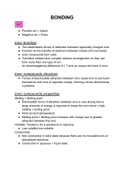Summary
Summary IB Chemistry chapter 4: BONDING
- Course
- Institution
- Book
Everything you need to help you with Chemistry chapter 4. These notes are perfectly summarized and organized in subtopic. Includes a compilation of information from the textbook, study guides, class notes and other IB resources. Super easy to read and a great amount of information to help you ace ...
[Show more]



